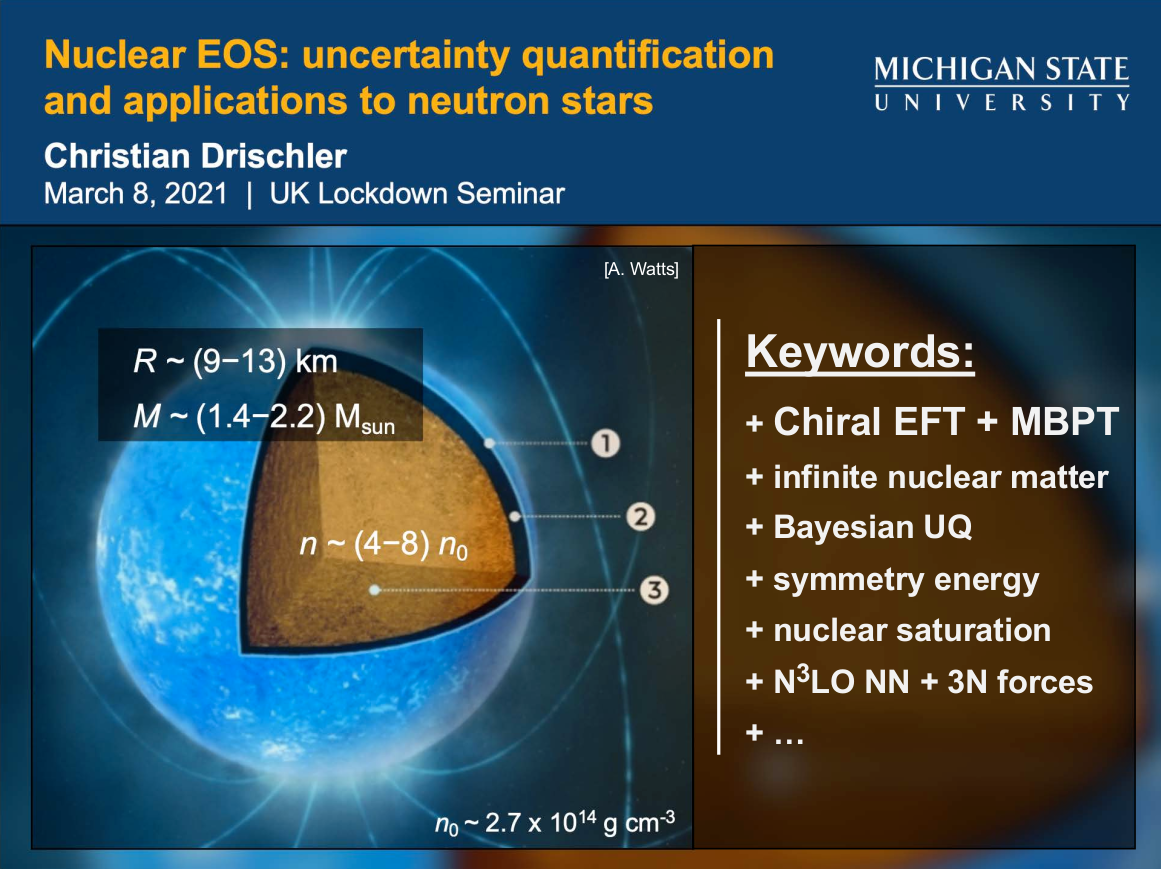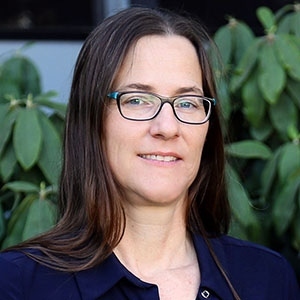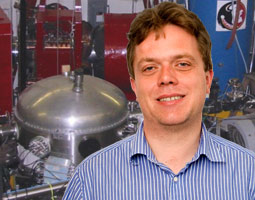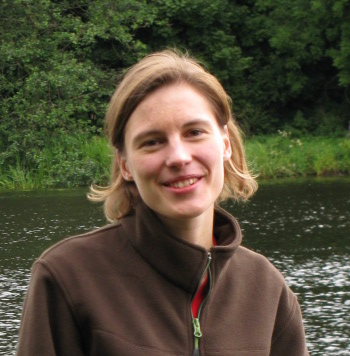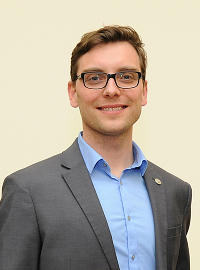Other Speakers
<<< PAGE 2
Recent neutron star observations have provided exciting insights into strongly interacting matter under extreme conditions. At the same time, chiral effective field theory (EFT) has developed into a powerful framework for studying nuclear interactions and nuclear matter properties with quantified uncertainties in the regime of interest for modeling neutron stars. Statistically meaningful comparisons between nuclear theory predictions and observational (as well as experimental) constraints on the nuclear equation of state (EOS) are needed in the era of multimessenger astronomy. In this lockdown seminar, I will show how Bayesian methods combined with systematic EFT calculations of the nuclear EOS allow us to efficiently quantify and propagate theoretical uncertainties to derived quantities. In particular, I will discuss the results of our recent statistical analysis of the nuclear EOS based on high-order calculations in many-body perturbation theory and their implications for neutron stars.
|
|||
Nuclear reactions play a fundamental role in terrestrial applications and the universe at large. They drive stellar evolution and the production of the elements, power nuclear reactors, and generate medical isotopes. Knowledge of nuclear reaction cross sections is key to simulating these processes and to shedding light on the environments in which they occur. Particularly compelling are astrophysics simulations. The extreme environments in which the important astrophysical processes take place and the exotic nature of the nuclei involved pose unique challenges for nuclear theory and experiment. I will discuss ongoing efforts to improve our knowledge of relevant reactions and of connecting cross sections to observables, with particular focus on heavy-element nucleosynthesis. The presentation will cover ongoing efforts to achieve predictive descriptions of nuclear reactions, as well as progress in developing indirect methods that rely on a combination of theory and experiment. Advances in both areas are needed to fully utilize the opportunities provided by modern experimental facilities and to answer some of the most compelling questions in science. This work is performed under the auspices of the U.S. Department of Energy by Lawrence Livermore National Laboratory under Contract DE-AC52-07NA27344, with support from LDRD Projects 19-ERD-017. |
|||
Nuclear shell structure is predicted to give rise to long-lived super heavy elements located around proton number Z=114,120 and neutron number N=184. Orbits stemming from these spherical gaps are lowered by deformation and influence the structure of neutron-rich actinide nuclei near proton number Z=100 and neutron number N=152,162. The structural properties of these lighter nuclei provide important data to test current models and predictions for the Island of Stability and the properties of super heavy elements. At the JAEA Tandem accelerator in Tokai, Japan, neutron-rich actinides produced via multi-nucleon transfer reactions of heavy ion beams impinging on actinide targets were studied using in-beam γ-ray spectroscopy. Recent results on neutron rich californium and fermium isotopes, as well as a brief outline of future projects, will be presented. |
|||
|
|||
The calibration of nuclear reactions in their role for astrophysical processes has become a central goal of nuclear experimental research, represented with strong programs at the current and upcoming accelerator facilities. Research at the John D. Fox Laboratory of Florida State University has focused on the development of innovative experimental equipment, such as the ANASEN active-target detector and its application to astrophysical reactions. Experimental results for the 7Be+d reactions affecting primordial nucleosynthesis are presented as well as results on the 18Ne(alpha,p) reaction in the breakout phase of thermonuclear astrophysical events. Also discussed will be the program around the recently installed large-acceptance Split-Pole Spectrograph, which is designed to provide calibrations and complementary information for these challenging direct measurements. |
|||
This talk will begin with an introduction to g-factor measurements and what they can tell us about nuclear structure. The focus will be on measurements of g factors of short-lived excited-states (non-isomeric states) by the transient-field and recoil in vacuum (RIV) methods. New data concerning the emergence of collectivity near 132Sn will be presented. Recent work on developing techniques and improving precision will be outlined, in particular how the time-differential (plunger) version of the RIV method can solve transient-field calibration problems, giving accurate independent g-factor measurements. |
|||
Shape coexistence, whereby nucleus exhibit a different deformations in states of similar energy, began as a rare and exotic phenomenon while now is suggested to be widespread and perhaps lurking in nearly every nucleus. Establishing shape coexistence is, however, challenging and requires highly-refined experimental methods, but provides one of the most demanding and stringent tests of modern nuclear theories and models. The low-energy Coulomb-excitation technique represents an ideal tool to study nuclear deformations. It allows for a direct determination of electromagnetic transition matrix elements between low-lying excited states including static quadrupole moments and signs. Those can be further analysed in terms of quadrupole invariants yielding model-independent information on shape parameters of individual states. The latter can be applied, however, only by reaching the required level of experimental detail. In this presentation I will focus on some recent results obtained from the Coulomb excitation studies of nuclei from two regions of nuclear chart: (i) the neutron-deficient mercury isotopes (Z=80, N~104), which structure can described by mixing of two different configurations that coexist at low excitation energy and, (ii) the stable even-even Mo and Cd isotopes near mid- neutron shell which were commonly attributed as the best examples of harmonic vibrational nuclei. Recent experimental and theoretical findings, however, seriously contradict such interpretation, indicating a key role of shape coexistence and triaxiality in the Z~50 and N~60 region. Measurements were performed at ISOLDE, CERN and HIL Warsaw facilities, respectively. Experimental results will be discussed in terms of the two-state mixing model and compared with the recent mean-field based theoretical calculations. Future perspectives will be outlined. |
|||
Laser spectroscopy provides a method for studying fundamental properties of nuclear ground and isomeric states, such as their spins, mean-square charge radii and electromagnetic moments. The in-source resonance ionisation technique is a highly efficient method, which when combined with the sensitivity of radiation detection and mass spectrometry devices, allows access to exotic nuclides with typically very low production rates at current ISOL facilities. In this talk, I will introduce the method and some of the techniques used to study isotopes in the vicinity of the Z=82 shell closure, a region of the nuclear chart that has proven a hot bed of shape phenomena. Highlights will be given of results from campaigns studying chains of gold, mercury and bismuth isotopes, performed at the CERN-ISOLDE facility. |
|||
The light mesons, the pion and the kaon, play key roles in quantum chromodynamics and in the structure and mass emergence of hadronic matter, ranging from the nucleon to nuclei. Substantial theoretical work on the structure of these mesons exists, however experimental data is extremely sparse. A future tagged deep inelastic scattering (TDIS) experiment is planned, in which the elusive mesonic content of the nucleon will be probed directly. This experiment will be performed in Hall A of Jefferson Lab, which was recently upgraded and provides a unique opportunity to explore this pioneering technique. The TDIS experiment will measure low momentum recoiling protons and pions in coincidence with electrons scattered from hydrogen and deuterium targets. Tagging of the final state hadrons will enhance the signal from deep inelastic scattering directly from partons in the nucleon’s virtual meson cloud. Key to the realisation of this experiment will be a high-rate capable time projection chamber, for measuring the hadrons in the final state and separating them from the high background rates expected. An overview of the proposed experiment and on-going developments will be given in this talk. |
|||
The internal structure of the nucleus, a finite quantum system of protons and neutrons, manifests in the occurrence of nuclear shells at the well-known magic numbers. Here, due to large energy gaps in the single-particle orbitals, unique pattern in the otherwise smooth nuclear observables appear. High-precision mass measurements of single isotopes allow a determination of the binding energy, reflecting the sum of all interactions within the nucleus, and calculation of the nucleon-separation energies. Many nuclear properties, in particular particle-emission probabilities and half-lives, depend on the available energy and phase-space of the decay. High-precision Q-value measurements of superallowed 0+ → 0+ beta decays allow for a precise determination of vector coupling strength in the weak interaction. These tests are possible in this unique electroweak decay mode, since the transition operator that connects the initial and final 0+ states is independent of any axial-vector contribution to the weak interaction. In this seminar we will discuss recent results of high-precision mass measurements for nuclear structure investigations and applications to Standard Model test based on superallowed beta decays with TRIUMF’s Ion Trap for Atomic and Nuclear science (TITAN) located at the ISAC radioactive beam facility, Vancouver. Further we will look into future programs and developments expanding the study of superallowed allowed decays using the newly established multiple-reflection time-of-flight mass spectrometry technique. |
|||
More than 2 decades ago the first in-beam study of 254-No has opened up the heaviest elements to precision studies. They have become drivers for modern experimental setups and the experimental sensitivity has continually increased. Today we are able to study the properties of the heaviest elements with a variety of methods. Chemical properties are being established up to Fl (114) and a variety of in-beam and decay spectroscopic approaches is available today. The talk will focus on the instrumentation and techniques for the study of the heaviest elements, including new approaches for lifetime measurements of excited states. |
|||
In this talk I will discuss the role of nucleon-nucleon (NN and 3N) correlations in atomic nuclei. The atomic nucleus consists of strongly interacting nucleons. It is noteworthy that for such strongly interacting quantum system the independent-particle model is proven to be a valid approximation and has provided the framework to explain many properties of nuclei. However, correlations between the nucleons, both of short- and long-range nature, modify the mean-field approximation and dilute the pure independent-particle picture. Notably, these correlations are thought to be the reason for the quenching of spectroscopic factors observed in (e,e’p), (p,2p) and transfer reactions. I will discuss a new phenomenological approach [1] to examine the role of NN short- and long-range correlations and their evolution in asymmetric systems. In particular, I will demonstrate how the recently observed increase of the high-momentum component of the proton momentum density in a neutron- rich nucleus correlates nicely with the reduced proton occupancies for states below or near the Fermi level as a function of the asymmetry (N-Z)/A. In the second part of this talk, I will focus on the effects of three-body (3N) forces in nuclear structure. Indeed, recent developments in ab initio approaches have shown the need to include 3N forces when starting from realistic NN potentials. Key observables, such as level lifetimes, appear to be sensitive to the details of the 3N interaction and thus provide unique benchmarks for ab initio theories. I will present results from experiments [2] on light nuclei to test and refine these new theoretical approaches. [1] S. Paschalis, M. Petri, A.O. Macchiavelli, O. Hen, E. Piasetzky, Physics Letters B 800 (2020) 135110 [2] S. Heil, M. Petri et al., arXiv:1912.02884, Physics Letters B (under review) |


